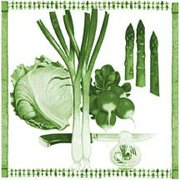Organic Produce: To Buy or Not to Buy?
July 3, 2012 at 12:11 p.m.
What a wonderful time of year! Spring rains have given way to the warm, balmy breezes of summer. It is the perfect time to reap earth’s bounty of fresh summer produce. Each year, it seems, we are faced with more and more choices at the supermarket. Should I buy organic produce? If so, why? Which fruits and vegetables are most important to purchase organic?
Concern around the word “organic” is quite common. Many think something unnatural has been added to a food, or get it confused with food being manipulated, such as with genetically modified foods. Most people who do not understand it safely keep their distance, mainly because of the higher cost. But perhaps because so many major food companies are switching to or at least offering some organic products due to consumer demand, nonorganic shoppers have become more curious.
Organic respects nature and its relationships. Maybe you have childhood memories of marching through brush on a wooded bluff and picking apples growing wild; the fruit so perfectly ripened you have to sink your teeth in on the spot. It is likely that apple was grown organically. Any food grown or raised without synthetic chemical fertilizers, pesticides, sewage, radiation and bioengineered products can be classified as organic.
Experts agree that pesticides can cause damage to human health as well as compromise the nutrient content of food, so it’s best to minimize our consumption. Rinsing reduces but does not eliminate pesticides. Root vegetables like those giant Russets are susceptible, too, due to the surrounding soil that nourishes them. Thin-skinned fruits and vegetables absorb pesticides more readily than thick-skinned produce, so for instance, berries and celery are more susceptible than bananas. Peeling fruits and vegetables helps, but valuable nutrients often go down the drain with the skin.
Ultimately, our goal is to live healthfully and enjoy life. If we have the ability to eliminate things that could be harmful to us or to our children and grandchildren, most people would prefer that choice. There’s no denying that organic selections are usually higher in cost than conventional products. The great news is that consumers are demanding higher-quality foods in general, and as a result organic options are becoming more available and affordable. By watching the store ads and shopping seasonally, you can unearth some great deals.
Keep in mind that fruits and vegetables, with all their nutrients, fiber and antioxidants, are a crucial part of your diet and you should aim for at least five servings daily, organic or not. (A serving is about a half-cup.) If you are able to buy only a few organic items that you consume regularly or want to have on hand for your family, the following guide may be helpful:
“Dirty Dozen”
These are the highest in pesticides; be sure to buy organic:
Celery; Peaches; Strawberries; Apples; Blueberries; Nectarines; Bell peppers; Spinach; Cherries; Kale/collard greens; Potatoes; Grapes (imported)
“Clean Fifteen”
Lowest in pesticides; organic not necessary:
Onions; Avocado; Sweet corn; Pineapple; Mangos; Sweet peas; Asparagus; Kiwi; Cabbage; Eggplant; Cantaloupe; Watermelon; Grapefruit; Sweet potato; Honeydew melon
The Environmental Working Group, a nonprofit organization developed to protect public health and the environment, provides a convenient print-out version of the guide at ewg.org/foodnews.
The best approach when considering fruits and vegetables of all seasons is to eat a varied diet, rinse all produce and buy organic when possible.
Nonprofit, accredited Bastyr University (bastyr.edu) offers multiple degrees in the natural health sciences, and clinical training at Bastyr Center for Natural Health (bastyrcenter.org), the region’s largest natural medicine clinic.
Fruit Salad with Lime Yogurt
Any combination of summer melons and berries, such as cantaloupe and blueberries, may be substituted in this zesty and refreshing simple fruit dessert.
Ingredients
Fruit Salad:
- 1 large, ripe honeydew melon, seeded and cut into 1½-inch chunks
- 2 cups strawberries, hulled and halved
- ¼ cup fresh lime juice
- 2 tablespoons honey
Lime Yogurt:
- 2 cups nonfat plain yogurt
- ¼ cup honey
- 1 tablespoon freshly grated lime zest
- 1 tablespoon fresh lime juice
Directions
In a large bowl, toss melon, strawberries, lime juice, and 2 tablespoons honey. Let stand for 15 minutes, stirring occasionally.
Meanwhile, in a small bowl, combine yogurt, ¼ cup honey, lime zest and juice, stirring until honey is well incorporated. Cover and refrigerate until chilled.
Top fruit salad with lime yogurt and serve.
Preparation time: 30 minutes
Makes 8 one-cup servings
Adapted by Catherine Lindberg from Delish.com at www.delish.com, 2012.
This article appeared in the July/August 2012 issue of Northwest Prime Time, the Puget Sound region’s monthly publication celebrating life after 50.





